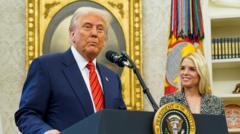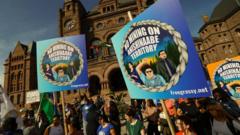With recent resignations and tariff wars impacting key trade relationships, Canada's political future hangs in the balance.
Canada's Political Landscape Shifts Amid Trade Turmoil and Leadership Change

Canada's Political Landscape Shifts Amid Trade Turmoil and Leadership Change
In the wake of significant political and economic shifts, Canada's federal election is shaping up differently than anticipated.
As Canada inches closer to its federal election this year, the political landscape has transformed dramatically, leading to uncertainty for the ruling Liberal Party. Initially, polls indicated a strong chance for the Conservative Party to reclaim power. However, recent events have dramatically altered that outlook.
One of the pivotal changes was the resignation of Justin Trudeau as prime minister, which has left the Liberal Party grappling for direction. In addition, the ongoing trade clash with the United States—exacerbated by former President Trump’s threats of tariffs—has emerged as a critical issue in the campaign. Despite Trump stepping back from some of his more extreme tariff threats, he has introduced significant tariffs on Canadian exports, particularly affecting the automotive sector, which is crucial for the Canadian economy.
The stringent measures include a hefty 25% tariff on cars, aluminum, and steel. Additionally, an auto parts tariff of the same rate is poised to roll out soon, creating more volatility for Canada’s trade-dependent industries. As part of its response, Canada has enacted retaliatory tariffs on various U.S. goods that are projected to accumulate approximately 30 billion Canadian dollars (around 22 billion USD) in revenue within a year.
Mark Carney, the new prime minister who assumed office in March, has introduced supplementary tariffs amounting to 8 billion Canadian dollars (about 5.7 billion USD), including a similar 25% tax on U.S.-produced vehicles—notably excluding auto parts. This nuanced strategic aim seeks to shield parts suppliers while addressing concerns over U.S. automotive imports.
As Canada navigates this complex interplay of domestic politics and foreign economic pressures, the Greater Toronto area is anticipated to play a decisive role in determining the outcome of the election, maintaining a watchful eye on how these developments affect voter sentiment in the lead-up to the polls. With time running out before voters head to the ballots, both parties are ramping up their efforts to secure support amid evolving currents of public opinion and economic reality.





















